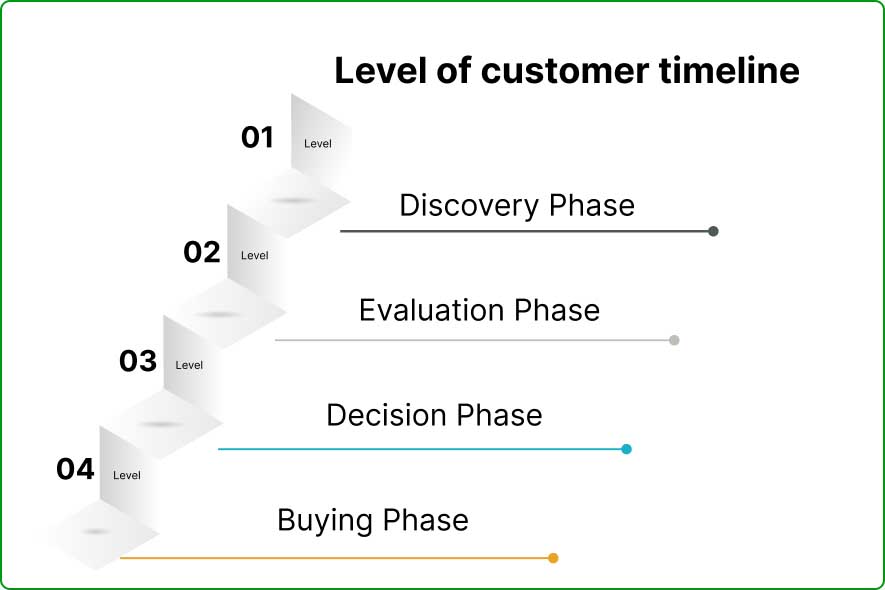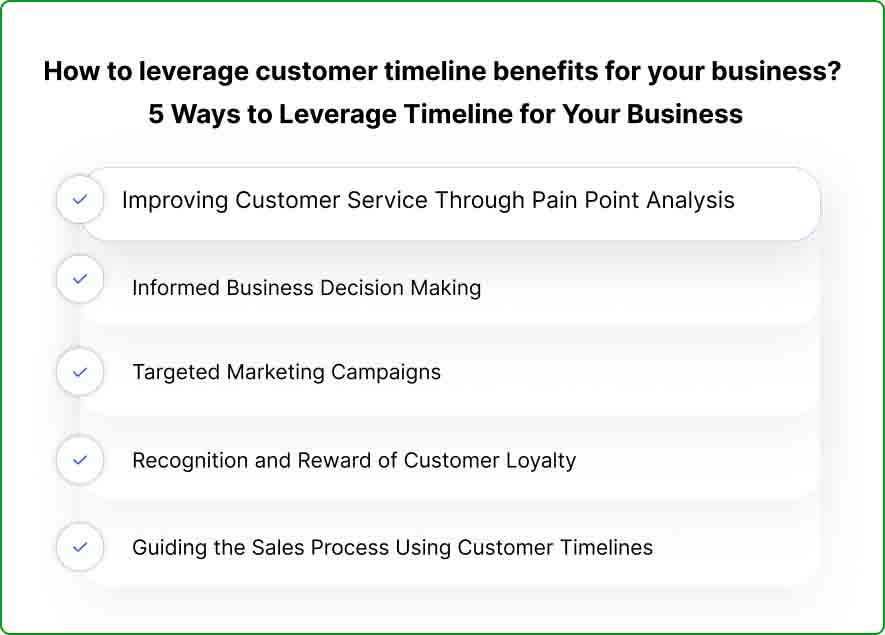 Customer Service
Customer Service

11 January, 2024

A business owner must know what a customer needs. Most people struggle when they have to deal with customers properly. In this situation, the customer timeline comes in as a guiding light. This is a list of dates and events.
You can consider it as a complete story of how customers interact with your business. With this timeline, you get to see what your customers like, when they’re ready to buy, and even what they might want next.
You can benefit in many ways by using it. Building strong relationships with customers, solving issues, and keeping pace within the team become a cup of tea with it. If you haven’t tried it yet, you should try it today.
Want to know more about it? Then no worries! Here, in this blog, I will share why this timeline for customers is important. You will also get to learn the definition of it, its benefits, its different levels, and many more. Let’s start the discussion with the definition of it.
Contents
A customer timeline is like a record that tracks a person’s journey with a company. It is like a helpful map that shows businesses how customers tick over time.
Why should businesses care? Well, it gives the lowdown on what customers prefer, their shopping habits, and when they’re ready to purchase.
Businesses can take this info to improve their customer service. They can nail targeted marketing and even come up with great new products that customers will love.
So, in simple terms, we can say that a customer timeline meaning is like a guide for businesses to tweak their game plan. It ensures that customers have a great experience from the first “Nice to meet you” to the repeat “Thanks for shopping with us!” Remember, for business success, it works like a weapon.

Knowing about this timeline is like opening many doors for happy customers. It is about taking a journey into their world to learn what they like, how they act, and what they need.
A study from Harvard Business Review found that customer happiness isn’t just about the stuff they buy; it’s about the feelings they get. Knowing the timeline of your customers helps businesses tap into those feelings.
Think about a customer who is always on social media, checking out the website, and making purchases now and then. Businesses can talk to them in ways they like. They can communicate on social media, with deals that pop up at just the right time, and even guess what they might want next.
Knowing about this timeline is a big deal because it makes customers feel connected. It increases customer engagement and drives sales. Remember, it passes to the customer’s journey timeline; smart, and super effective!

| Customer Timeline | Action |
| Discovery Phase | Recognize the need or desire for a product |
| Evaluation Phase | Explore options for the products |
| Decision Phase | One product gains customer’s trust |
| Buying Phase | The customer purchases the desired product |
| Post-Transaction Phase | Feedback section |
In the timeline of customers, there are some levels that every business owner should know. After knowing these levels you can engage your customers and also can turn them into your loyal customers.
These levels seem similar to customer engagement levels but they are not. So, what are the levels? You will get the answer here.
Let’s learn the levels of the timeline of the customer here.
The first level of the timeline for customers is the Discovery Phase. At this level, customers first recognize a need or desire. They share what they would like to purchase from a business,
For example, a customer visits your restaurant and wants to have some food. First, they would take a seat and try to understand the ambiance. When they like it, they will ask for the menu. They will go through the menu, see the prices, and will recognize what they want.
A well-designed menu helps the customer to choose the right food. Even they might ask you about the food and seek suggestions.
Through this, you can capture their attention. You can gently guide them toward realizing that their current choice is good. Alternatively, suggest something else they might like to have.
As customers move into the Evaluation Phase, they shift from passive observers to active participants. This is the stage where they explore options, seeking information to make informed decisions.
Businesses become guides in this phase. It offers valuable content and insights to help in the decision-making process. They check reviews and rely on different feedback online to process to the next level.
In a recent study by McKinsey & Company 8 out of 10, B2B buyers trust reviews and testimonials from other users when deciding what to buy.
For example, a customer wants to purchase a pizza from the provided food menu. They explore all the options for the pizza. Before deciding to purchase one pizza, they check online reviews.
They go through different testimonials to find out what others say about the shop and pizza. It helps them to shape their preferences and evaluate the business’s product properly.
After the evaluation phase, the customer enters the Decision Phase. You can call it the climax of the journey. This is the moment of choice, where businesses need to gain the trust of their customer.
Clear calls-to-action, persuasive messaging, and enticing offers take center stage. It’s about addressing any concerns and showcasing the value that leads to the final decision.
For example, in this phase when a customer visits and checks the online review then they make up their minds about what they should order.
Here, the restaurant owner can offer clear guidance, on which pizza is tasty, and offer a special combo and a discount. They address any concerns, showcasing the value of the pizza. This helps customers confidently make their final choices for a perfect pizza selection.
With the decision made, the Buying Phase unfolds. This goes beyond a simple transaction. It creates an experience.
Businesses ensure a seamless buying process, providing secure options and personalized recommendations. It is the satisfaction that comes with a purchase, laying the groundwork for potential future engagements.
Salesforce shows that 89% of customers are more likely to make a repeat purchase after a positive post-purchase experience.
For example, when the customer has made up their mind, they move to place an order for the pizza. Here, they will purchase the pizza and the shop owner will make money. The owner has sold one of his products, which is an achievement for him.
The story doesn’t end at the purchase; it evolves into the Post-Transaction Phase. This is the last level of the timeline. Here, businesses play a crucial role in turning a one-time buyer into a loyal advocate.
Exceptional customer support, feedback collection, and post-purchase relationship nurturing become vital. It’s about solidifying loyalty and transforming individuals into vocal supporters of the brand.
For example, the shop owner can ask the customer about the service and the taste of the pizza. If it is good and the customer is happy then politely ask the customer to write feedback online Remember, to say “thank you” to them to show your gratitude. Everyone acknowledges good customer service.
Hubspot shows that a good customer service experience heavily impacts recommendations. Consumers who rate a company’s service as “good” are 38% more likely to recommend that company.
Let’s learn the way to set up a customer service timeline here:
You can use the timeline of customers for your business in many ways. Remember, this timeline helps your business to flourish and also brings success. Want to know how you can use it for your business?
Here, I will explain the ways that you can use this timeline. So, let’s explore the ways to leverage for your business:

Continuously tracking your customer journey with your organization becomes easier. You can analyze their experiences and offer precisely their desired services.
For example, many customers might abandon their carts at a certain stage. In this case, address the underlying issues to enhance customer service. Fixing the issues will be easier for you.
This demonstrates your commitment to customer satisfaction. It also strengthens your relationships by showcasing a profound understanding of your consumers.
Analyzing these timelines provides valuable insights. It helps understand the impact of various business decisions on the length and events of the customer journey.
By closely evaluating aspects like abandoned carts and unsubscribes, businesses can strategize plans. These plans are based on what works and what doesn’t.
Exploring the reasons some timelines are longer than others allows for a deeper understanding. This promotes better business decisions, stronger relationships, and sustainable growth.
Regularly tracking these timelines reveals trends for targeted marketing campaigns. Identifying patterns is crucial, such as noticing increased cart abandonment before payday. This insight allows businesses to customize campaigns with discounts.
It also encourages customers to complete purchases. Adaptable marketing strategies contribute to a smoother customer journey. They also enhance the likelihood of successful transactions.
The timeline of customers serves as a visual representation of loyalty. Identifying customers who consistently engage with your brand allows for targeted rewards. It cultivates a positive business reputation. Remember that a business’s main goal is customer engagement.
By acknowledging and appreciating loyal customers, businesses can solidify relationships. This can potentially turn customers into brand advocates, contributing to organic growth.
Understanding and aligning with the customer’s timeline is crucial in the sales process. This involves identifying the sequence of events leading to a purchase decision. It adapts strategies based on the customer’s evolving needs.
Ultimately, influencing the customer’s timeline involves persuasive techniques. It requires effective negotiation and creating a sense of urgency to drive favorable decisions.
So, it can be said that using this timeline gives businesses the power to refine their strategies. Now, let’s learn the benefits of this timeline for your business.
With a proper timeline for customers, you can get many benefits. These benefits help in your business growth and many more.
Let’s explore the key benefits of it together here:
Having a timeline is like having a savior for efficiency. It simplifies things, making sure everyone on the team can quickly find the same info.
Tasks get checked off the to-do list effortlessly. That is why client follow-ups become a breeze. Here, troubleshooting occurs in a snap. Delivering top-notch service becomes second nature.
Businesses understand exactly what clients want by using these timelines. It is like using a cheat code to figure out customer needs and behaviors.
With this knowledge, businesses can provide personalized service. It helps in earning trust and building strong relationships. It helps to make connections that last. With its help, businesses do not just meet expectations! They go beyond it and create relationships that last for a long time.
Bring the teamwork vibe, linking up sales, support, and marketing with this timeline. They are like sales spark ideas for products, support zaps issues pronto, and marketing hones its game.
Consider it as an all-access pass that keeps everyone on the same page. It speeds up decisions and minimizes mix-ups between teams. In simple words, we can say that this timeline keeps the business flow in perfect harmony.
It neatly lays out interactions in chronological order. It provides a panoramic view of the customer journey timeline. This is a shortcut to swift and effective solutions.
What is the outcome? Customers are happier, and the overall experience becomes easier. It transforms challenges into opportunities for elevated satisfaction and a better customer journey.
You can discover valuable insights about the behavior patterns of the customer easily with this timeline. Your team can make smart moves based on what the data shows.
Well, consider it like having a guide that helps you effortlessly and improve your strategies. With these timelines, you can make decisions that connect with your audience and move your strategies forward.
Upgrade communication by keeping an eye on customer interactions with the help of it. A clear timeline lets you send messages that are both on time and fitting, strengthening the bond between your brand and the customer.
It is like having the best way to communicate. This makes sure your messages land right when they should. It builds a connection that feels natural and lasting.
Shaping interactions based on customer history is the easiest thing that you can do with this timeline. With it, you can uncover preferences and deliver an experience that speaks to individual needs.
It allows you to create an experience that feels just right, This builds a personal connection that is more than just business. Remember, this experience lasts for a long time.
A business timeline has key goals: boost efficiency, set expectations, and enhance visibility. This is important as it shows project steps visually and aids task management.
The main goal of a business timeline is to set expectations and enhance visibility. It efficiently manages tasks and project progress through visual representation.
When using this timeline, it’s important to consider factors such as data volume. Additionally, assess the frequency of updates and the suitability of custom solutions for specific data capture needs.
The complexity of the data being tracked may necessitate a certain level of technical knowledge for utilizing advanced features.
Using a timeline typically does not demand advanced technical skills. Nonetheless, the complexity of tracked data may warrant some technical proficiency, dependent on organizational needs
Track timelines to spot trends in customer journeys, like increased abandoned carts before payday, for better customer engagement. Boost your business by offering discounts and special deals during key periods This approach encourages the completion of transactions and boosts overall sales.
Tracking these timelines offers a notable benefit in unveiling loyal customers who consistently engage with a brand. Businesses can identify these repeat customers and implement rewarding strategies, enhancing their reputation.
The timeline visually represents customer loyalty. This allows businesses to acknowledge and appreciate loyal patrons. It ultimately contributes to a positive business image and promotes continued customer satisfaction.
Now you know that the customer timeline helps your business shine. It goes beyond just making customers happy. It plays a key role in building strong relationships and solving problems effortlessly within your team.
Moreover, it keeps your business going well, builds strong connections, and encourages teamwork. It swiftly solves problems, provides valuable insights, improves communication, and offers personalized experiences.